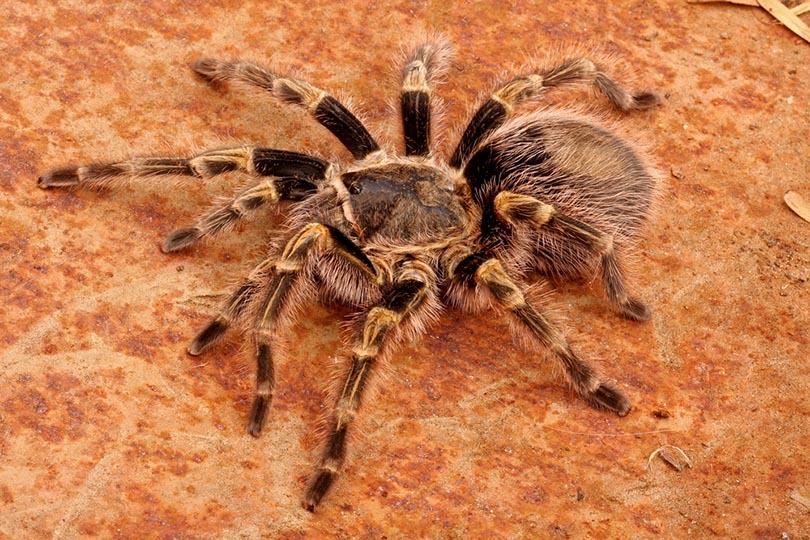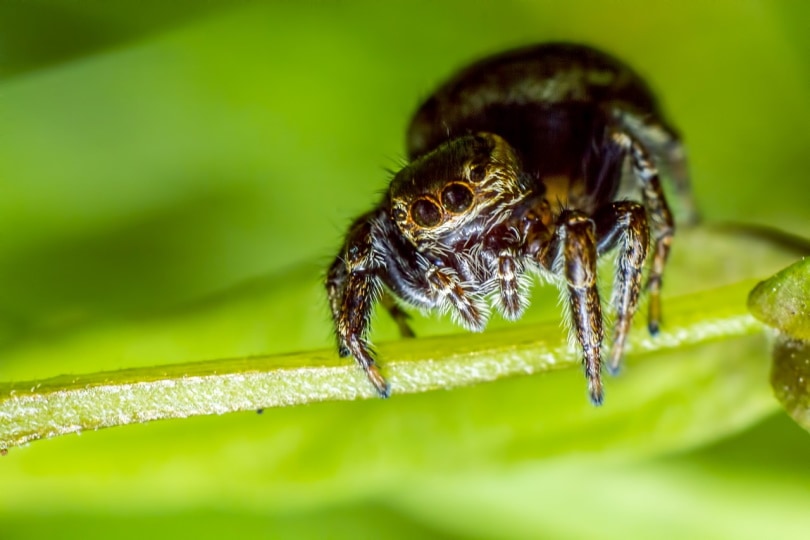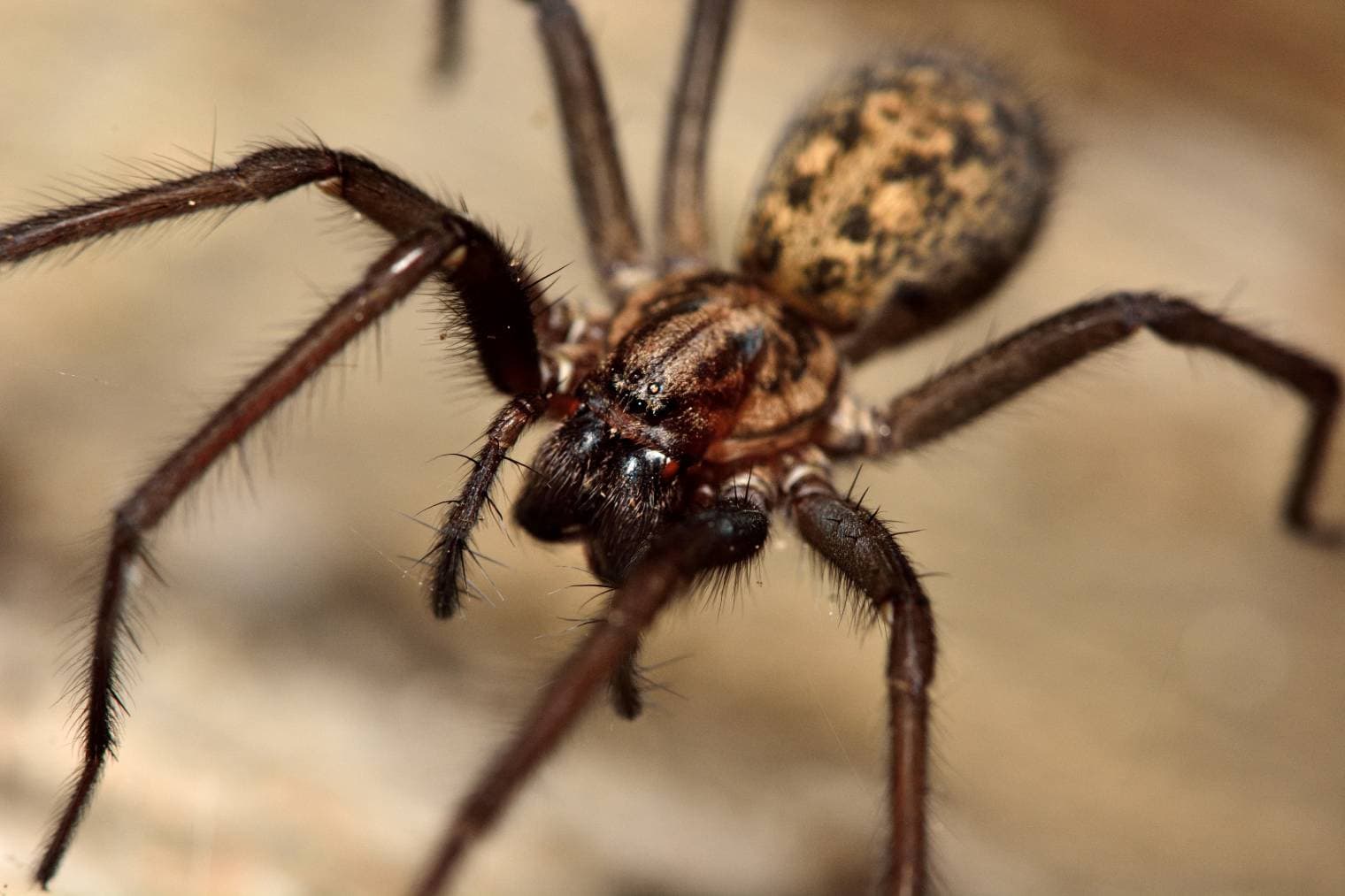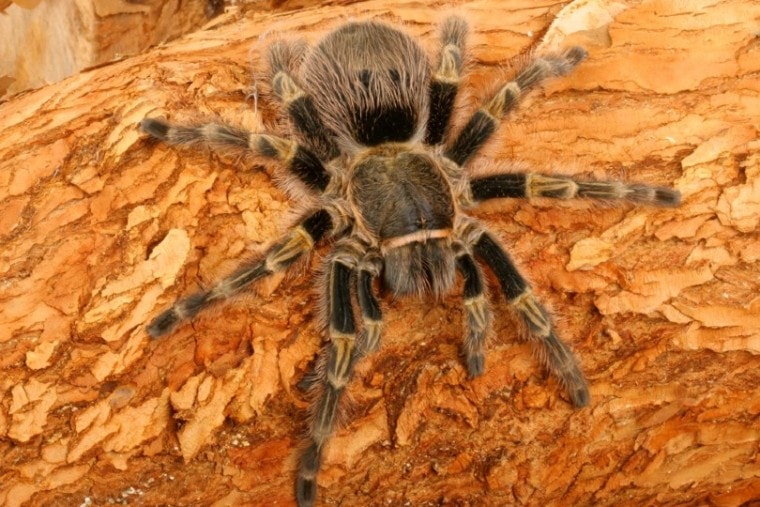
The Chaco Golden is a terrestrial tarantula that is native to Paraguay. The females of this species live longer than the males, which is largely due to how the species breeds. They take quite a few years to grow, especially compared to other tarantulas. If you purchase a baby, it will be years before the spider grows into an adult.
This species is rather docile, which is why it is so popular. They also aren’t aggressive in most cases. However, this varies significantly from spider to spider. While they are burrowing tarantulas, they don’t tend to dig that much. When they get older, they typically just move the substrate of their enclosure around.
Quick Facts About the Chaco Golden Knee Tarantula
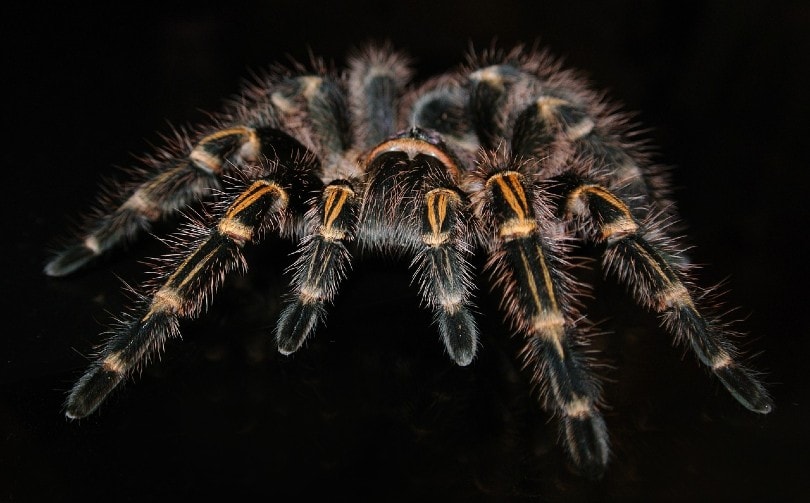
| Species Name: | Chaco Golden Knee Tarantula |
| Care Level: | Moderate |
| Temperament: | Docile |
| Color: | Brown or black |
| Lifespan: | 6-7 (males); 20-25 (female) |
| Size: | 7-8” |
| Diet: | Small insects |
| Minimum Tank Size: | Small |
| Tank Set-Up: | Minimal, only a hiding space needed |
| Compatibility: | None |
Chaco Golden Knee Tarantula Overview

This species is one of the best options for beginner tarantula owners. They are sweet and calm, so they don’t require much experienced handling. They are quite hardy, so you aren’t going to kill them easily. They can put up with errors from their owner, especially while you are learning. This makes them one of the best starter tarantulas out there. If you’ve never owned a tarantula before, we recommend this one.
These tarantulas are characterized by the yellow stripes on their knees, hence their name. The males live significantly shorter lifespans than the females. Compared to tarantulas in the same genus, they grow quite quickly. However, most new owners will be surprised that they will take years to reach full size, where their adult coloration is prominent.
While most tarantulas don’t require much activity, these are extremely active. They will make themselves busy by digging holes and moving their substrate around, two of their favorite things to do.
It is recommended that most owners purchase a spiderling first. It will not bite due to its smaller size. Instead, it will often be intimidated by the sheer size of the human hand. Purchasing a baby provides owners a chance to get to know their spider before it’s large enough to bite.
The care needs for these tarantulas are simple. They don’t need much expert care and will generally thrive in most environments.

How Much Do Chaco Golden Knee Tarantulas Cost?
These tarantulas can often be purchased from a variety of different sources. Pet stores often carry them, but it is possible to purchase them directly from a breeder as well. It is recommended that you speak to someone who owns tarantulas before you purchase one and do plenty of research. It is important to know what you’re getting into before you decide to adopt a spider.
The cost of the tarantula will depend on several factors. Usually, you can purchase one for about $50. Some breeders will charge more if the tarantulas are particularly cared for. Sometimes, tarantulas may cost as much as $100, especially if they are healthy and well-bred.
You should check the temperament and health of any tarantula that you are thinking about purchasing. Adult tarantulas should be the largest in their abdomen. Tarantulas that drag their abdomen on the ground typically aren’t healthy. They should stand on the tips of their legs and walk with their body raised.
Testing a tarantula’s temperament is often easy enough. You can gently touch its abdomen with a stick or paintbrush. If the tarantula ignores it, they are tame. Aggressive tarantulas will raise their legs and fangs. A tarantula that runs away may be a bit nervous but will often come around with socialization.
Typical Behavior & Temperament
Despite being quite large, Chaco Golden Knee Tarantulas are also extremely gentle. They are one of the most docile tarantulas around, which is exactly why they are often recommended for first-time owners. Females are particularly laidback and easy to handle. Males can be a bit aggressive, as their only motivation in life is to find a mate. Therefore, they may become somewhat destructive. If you’re new around tarantulas, we recommend a female.
Its temperament can shift substantially as it ages, though. Also, it can be difficult to determine the sex of a spider when it is young. A male can easily be mistaken for a female if it is larger than normal. For this reason, don’t be surprised if your tarantula is a bit more aggressive than you’d otherwise like.

Appearance & Varieties
These tarantulas look like you’d expect. They are a bit flashy in appearance, with the golden stripes on their legs and lighter-colored hairs covering their body. Typically, their main color is brown and black.
As larger tarantulas, they can reach up to 8.5”. Females are typically larger than males. These tarantulas do have hairs that they can throw if they get angry. One of the best ways to determine the temperament of a tarantula is to check for bald spots on its back. If it has bald spots, it has previously thrown hairs.
How to Take Care of a Chaco Golden Knee Tarantula
You should handle your tarantula occasionally to get it used to being handled. However, you should not handle it regularly, as this can cause unnecessary stress. When handling, you should be extremely gentle. Hold your tarantula close to the ground in case it decides to jump. Long fails can seriously injure it. Be sure to handle the tarantula in an area without hiding spots. The last thing that you want to do is lose your pet.
Be careful not to spook your tarantula, which can be quite easy to do with your breath alone. Preferably, you should place your hand in your spider’s enclosure and coax them onto it. You shouldn’t pick them up, as this can frighten them and cause them to be aggressive. Let the tarantula walk over your hand and become used to the new surface before lifting it out.

Habitat, Tank Conditions & Setup
Because tarantulas spend their life on the ground, the floor space of the tank matters more than the height. The tarantulas won’t use the height of their tank, so it can be quite short. You should fill the tank up with quite a bit of substrate to ensure that there is plenty for them to move around. Adults should have about 5” of substrate, while spiderlings often only need 1”. This species likes to dig, so more is often better.
You cannot keep multiple tarantulas in the same tank — there should only be one per enclosure. Most tarantulas prefer smaller enclosures so they can’t get “lost.” A shoe-box-size container is often plenty. For larger enclosures, be sure you provide places for the tarantula to hide. Empty coconut shells make great “houses.”
Watch out for ants, as these can easily kill your tarantula. An easy way to prevent this is to put your pet’s tank on a table and then cover the legs with a healthy layer of petroleum jelly. Ants will be unable to get through this layer.
Organic potting soil, coconut fiber mulch, and other similar substrates are the best options. If you need to increase the humidity in the tank, perlite can be added. These are the safest options for your tarantula. You should never use wood shavings, as these contain chemicals and oils that can be dangerous to your tarantula. Cedar is particularly dangerous for most small creatures.
Spray your substrate with water to moisten it, and then squeeze the water out of it. It should hold its shape after it is squeezed, but not be dripping wet. Keep it at this consistency. Remember, these tarantulas are from the tropics. Replace the substrate two or three times a year.
You can reuse substrate if you treat it well. Do this by pouring a generous amount of boiling water on it and letting it sit for about 10 minutes. This will kill any bacteria on the substrate. Do this every time that you change the bedding.
Most pet stores sell blocks of substrate. These are quite affordable and simple to use. Because they are compressed with heat, they are also sterile. These blocks do not need to be treated before being used. Instead, you can simply soak them in water to increase their moisture content and use them. New bedding is preferable to treated old bedding.
Adult tarantulas often do not need places to hide if the enclosure is small enough. In larger enclosures, hiding places are essential. Hollowed bark and coconut shells are often suitable and add climbing spots for your tarantula as well. Use fake plants if you use any at all. Real plants can attract pests and parasites. Furthermore, ensure that there aren’t too many hiding spots, as this can make it easier for the prey to hide.
These tarantulas do not need lighting or heat. In fact, these can cause issues. Avoid direct sunlight as well. Room temperature is fine for these spiders, so do not add extra heating pads. Tarantulas cannot sense heat well, so they may not move to a cooler spot if they get too hot. Spiders can die of dehydration in this way. They are more sensitive to heat than cold.
Do Chaco Golden Knee Tarantulas Get Along With Other Pets?
No, these tarantulas will either eat other pets or get eaten. You should preferably not keep them around other pets at all. This can stress them out, as well as the other pets.

What to Feed Your Chaco Golden Knee Tarantulas
Baby spiders will need to be fed pinhead crickets or small baby roaches about twice a week. You can feed them more often if you choose, but this is enough for most spiders. Increase the size of the prey as your tarantula gets bigger. You should remove any leftovers and uneaten prey.
Fill up a water dish with fresh water regularly. Small spiders may not drink from the dish, but they will be able to suck directly from the substrate. You can put a rock in the middle of the bowl so your tarantula does not have to worry about falling in. If they do, they will have something to climb onto.
You can feed your tarantula different prey items, including crickets, mealworms, maggots, and roaches. Always purchase these from a supplier. Wild-caught insects often have parasites, which can injure your tarantula. Full-grown tarantulas can be fed pinky mice occasionally. However, the excess calcium can cause molting problems. Only feed them these very occasionally.
Simply release the prey into the spider’s cage, and it should do the rest. These tarantulas do not make webs to trap their prey. Instead, they actively hunt it.
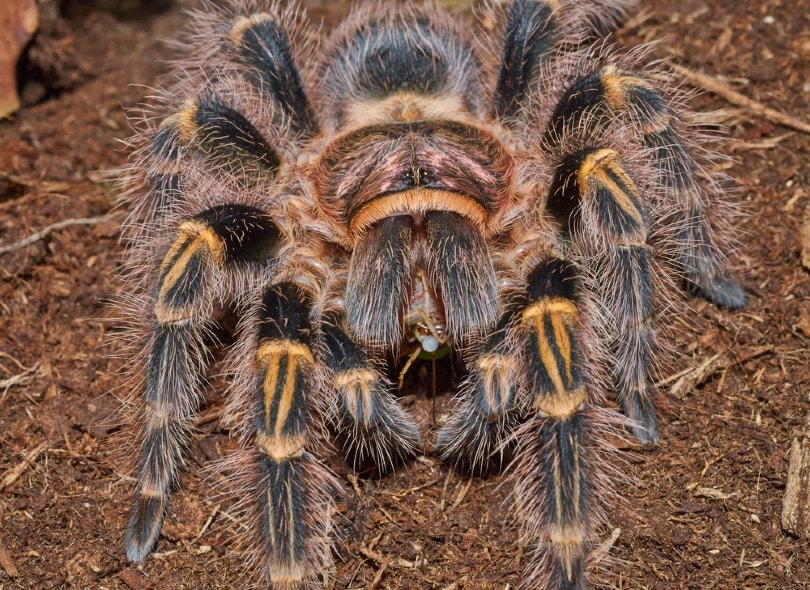
Keeping Your Chaco Golden Knee Tarantulas Healthy
If your tarantula’s enclosure is set up correctly, then it should stay healthy. The important thing to remember is that its substrate needs to be sprayed regularly. Often, you should only spray the half that your tarantula isn’t on. If you spray your tarantula, you will upset it. If the substrate gets dry, though, then the humidity in the tank can fall substantially.
Any substrate with mold or mites should be changed immediately, even if it isn’t time to change it yet. Mold can grow directly on your tarantula, which can cause breathing problems.
If you notice mites, you should remove the tarantula and inspect it to see if any mites are attached to it. Use a paper towel to remove these mites. Pay close attention to any areas where the mites can cling to, such as the legs and mouth of your tarantula.
Tarantulas do not bleed red. Instead, they bleed a milky, semi-clear substance. They often won’t bleed profusely either, as it is more of an ooze. They do not clot like mammals, so any wound needs to be treated right away to prevent excessive bleeding. Wounds can be treated with a Q-tip and water-based glue. Liquid Band-Aid also works. Be sure not to use these substances extensively, though, as they can cause movement problems for your tarantula.
Dehydration is a common problem, especially if heat pads are used. If its abdomen is wrinkled or deflated, the spider is dehydrated. In this case, you need to flip your tarantula over gently and drop water directly onto its fangs. You just need a few drops. Your tarantula should quickly regain its strength. Then, fix whatever issue caused your tarantula to become injured in the first place.
Breeding
It is generally not recommended to breed tarantulas unless you are a professional. Females will attempt to eat the male when they are done!
Breeding is usually as simple as placing the male in the female’s habitat. They should start the courtship process. When they are done, the male must be rescued before he is eaten.
Are Chaco Golden Knee Tarantulas Suitable for You?
If you’re interested in a tarantula, then this is a good species to start with. It is important to realize that these tarantulas are not your average pets. They can’t be handled much and are not affectionate. However, they are easy to take care of.
They don’t require much room. However, they do require specialized care. For instance, they will need the humidity in their tank kept at a decently high level. They do not need heating or lighting, though, which lowers the cost of their habitat substantially. Adults can live in a small container. The size of a shoebox is often suitable.
Their bedding needs to be changed regularly, but this is easy to do and rather inexpensive. The only diseases that these spiders are prone to can easily be prevented with the correct care. For instance, lung problems are often caused by low humidity. If you keep the humidity high enough, you don’t have to worry about this.
These tarantulas are great starter pets if you’re looking for something more unusual. Just be sure you know what you’re getting into when it comes to their temperament and care needs.
Featured Image Credit: Audrey Snider-Bell, Shutterstock


